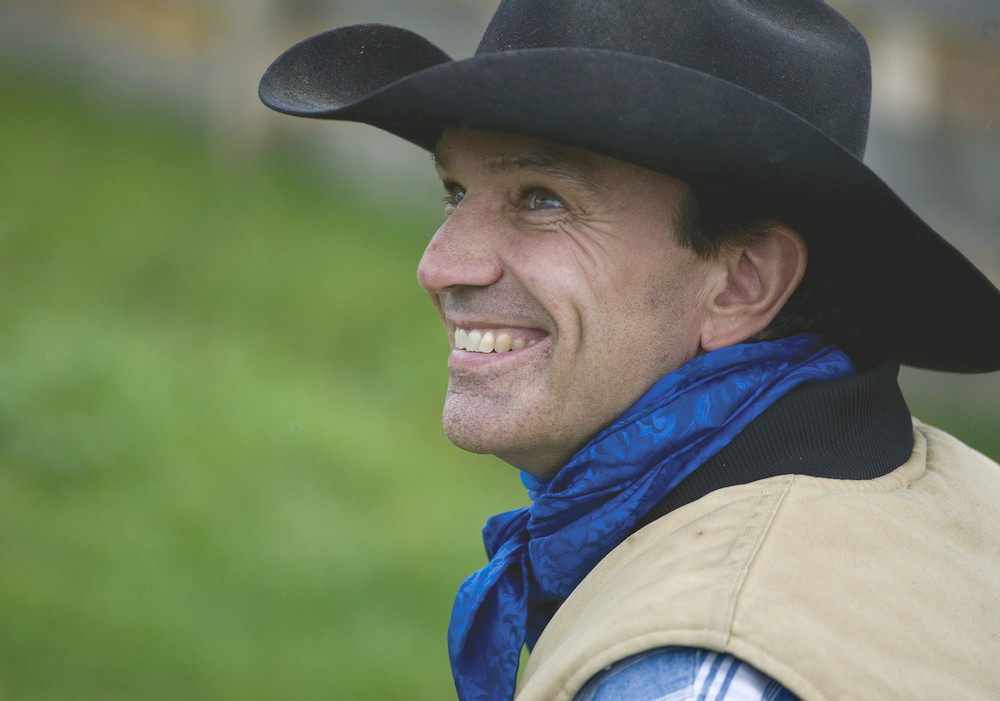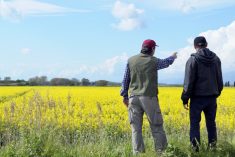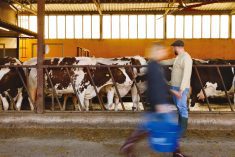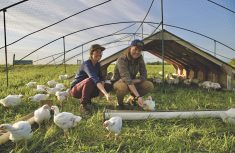Training new and existing employees about the ever-changing tasks on the farm is essential if you hope to build and maintain a great farm team. But how much should you invest in training? Are you already there, or could your farm make big strides in its efficiency if you stepped up your training initiatives?
Such questions do have answers, but it takes some clear thinking and a commitment to two HR pillars to get there. So keep your training programs doable, and make sure you document what you’ve done
There are other crucial questions too, especially these: Are you ensuring your employees know how to work safely? Are you meeting today’s health and safety regulatory requirements?
Read Also

Farmland values: assumptions and realities
Where farmland values are headed and what decisions farmers should make
Farmers can win big if they can answer yes to these questions. More and more, as you’ll see below, learning how to set up a great program for safety training can help you train countless other skills too.
Every day is a training day
Every farm owner or manager is responsible for supervising new employees and to ensure they are comfortable, safe and competent when they’re doing the tasks they’re assigned. It’s a role that is never finished.
“The important thing is making it doable,” says Reg Steward of Buffalo Creek Consulting & Cowboy Services in British Columbia. Steward helps farm and ranch managers develop training and competency determination strategies that are practical and executable.
Steward also believes the best way to implement good training processes is to make them part of the way you do business. That helps ensure everybody can do their jobs as efficiently and safely as possible.
So when you have meetings about crop production or where you’re going to move the cows, use the opportunity to refresh everyone about procedures and safety, Steward recommends.
Also get out of the mindset that training only happens in a formal setting or at a pre-announced place or time. Instead, training is an ongoing process of coaching and support as people work and learn together on the farm.
“Coaching goes on all the time,” Steward says. “We have excellent people doing excellent work but sometimes they don’t have any protocols in place. They haven’t made it part of the way they do business, or don’t stop to do a more formal meeting before they undertake a new task.”
For example, Steward suggests making time for a five-minute conversation before you do something out of the norm, like disassembling an old shed. A short, focused conversation gives you a chance to talk about potential hazards and make sure everyone involved is aware of risks like hantavirus. “That is good business practice,” Steward says.
Remember, though, that you might not be the best person to train a new employee in every area. The first rule of training is: “when in doubt, don’t.”
“If you’re not sure, don’t proceed, don’t fake your way through it,” says Steward. “Make sure that you’re right because there’s very little forgiveness with livestock, equipment or machinery when the task is not done properly.”
It’s fine to delegate some of the training responsibility to someone more experienced and qualified to explain different tasks or operating procedures, although the overall responsibility for the performance of any employee always rests with the farm owner.
Also make sure your employees know that it’s never too late to ask questions. “If anyone is working on a piece of equipment or around animals or whatever it might be, they have the right and the obligation to stop and say, ‘I don’t know what I’m doing here, can you help me?’” Steward says. This keeps people from getting hurt and can also stop things from getting broken. “It’s much better to ask the right question.”
Make it real

Every jurisdiction in Canada has health and safety regulations, and the courts can impose financial penalties against a farm employer if there are serious or repeated training infractions. With any training plan, health and safety is the number one priority, or at least it should be, says Steward.
Keep in mind, too, that there’s a benefit, not just a cost to safety training, and it’s a benefit that goes beyond the downtime when there’s an accident.
“The agricultural labour pool is very shallow in our country,” Steward says. So, to become a place where people want to work, demonstrate that you’re committed to their safety and that it’s a priority on your farm to make sure everyone goes home safe at the end of every day.
That means your safety training goes way beyond simply having a binder of information on a shelf somewhere.“The only way that health and safety can be done realistically in agriculture is when you make it part of the way you do business,” Steward says. “The slave to a binder, where you come in at the end of a 14-hour day and start checking boxes, is no help, and frankly, it just isn’t going to happen.”
Tell me, show me, watch me
When Steward works with farmers to set up on-farm training and assessment practices for things like livestock and tractor safety, he starts with what he calls the ABCs.
“A, what’s the problem, B, what have you done about it, and C, how can you prove it?” he says. “For the most part, farmers and ranchers are pretty good at A and B, but they’re not very good at C, so until we make C part of the integrated process then we’re going to miss that element all the time.”
That is the element that will verify an employer’s due diligence has been met. If it doesn’t get written down, it is tough to prove it happened, so it’s smart to do this writing upfront rather than wish you had after a worst-case scenario.
Steward suggests a simple formula for orientating and training new, returning or existing employees that boils down to three concepts: tell me, show me and watch me.
“At the ‘tell me’ stage, you tell the person how to do the job. At the ‘show me’ stage, you demonstrate how to do it and at the ‘watch me’ stage you determine their competency,” he says.
“No farmer is going to hand the keys of a $250,000 tractor over to someone without making sure they know what they are doing. If something happens and someone says, ‘Who put that person on that equipment?’ someone has to say, ‘I did’. When you say that as a supervisor, then the next question is, ‘What made that person qualified to do that?’ At that point, it’s important to be able to provide documentation that you have told them and shown them how to do the job and watched them to ensure their competency.”
Supervision needs to be ongoing, and the documentation doesn’t have to be onerous, he adds.
“When you use that document to confirm your onboarding and your competency determination, you have a guide to ensure you did not miss anything,” he says.
Organizations such as AgSafeBC, CASA (the Canadian Agricultural Safety Association) and CAHRC (the Canadian Agricultural Human Resource Council) have resources and templates to help employers set up systems to guide training and competency determination. Using these resources also helps you build a record of the training you’ve done.
Steward would like to see rewards for farms that excel in health and safety training, not just financial penalties for farms that don’t. “We have some very responsible producers,” he says. “Insurance companies would do well to reward them by offering them a reduced premium upon proof of an active and robust safety program … it shows prudence, due diligence and an understanding of the benefit of having a good, safe, healthy, effective workplace.”
Training plus a grant
The Canadian Agricultural Human Resource Council has launched an online program called AgriWorkplace Skills Training featuring National Occupational Standards to help farmers set up on-farm training programs.
The standards are based on multi-year research into the many roles on the farm, from labourer all the way up, and the HR Toolkit then provides detailed job-specific information about each of those roles, the expectations of the person hired to perform them, and the specific skills and competencies required. It also includes interview guides and on-the-job training information.
Now CAHRC has built on these resources by developing short training programs to help fill some of the gaps in on-farm skills and knowledge.
AgriWorkplace Skills Training is a pilot project across Canada, initially to farmers in commodity sectors that include apples, beef, crops, dairy, greenhouse production, mushrooms and swine.
Employers can register for the program on CAHRC’s AgAchieve site and participate in an on-the-job training and e-learning demonstration.
After completing that course, they get access to the complete program that teaches (or refreshes) information about the best methods for employee training.
Once training is completed, the employer can apply for a wage subsidy of up to $5,000 per employee, and up to $7,500 for employees who are members of equity-deserving groups.
Employees also have the option to apply for a completion bonus to help offset the costs of barriers such as child care or transportation costs to and from the workplace for the duration of their program training.
“The program is open to new hires or employees who are already working with an employer,” says Aaron Brisson, project lead. “They (farmers) are able to train their workers against the relevant standards, which lists each major task area.”
The program can’t cover every single task for every single job on the farm, but it does have many of them, and its templates can easily be customized by any farm owner to suit their own operational needs. “It takes a lot of the work out,” says Jade Reeve, CAHRC’s AgriSkills program manager.
Farmers add their employees into the system where they can add specific training events into a calendar, track the employees’ progress and check off the skills or tasks they’ve been trained for. It takes on average about three months to complete the employee training.
– This article was originally published in the January 2024 issue of Country Guide.
















